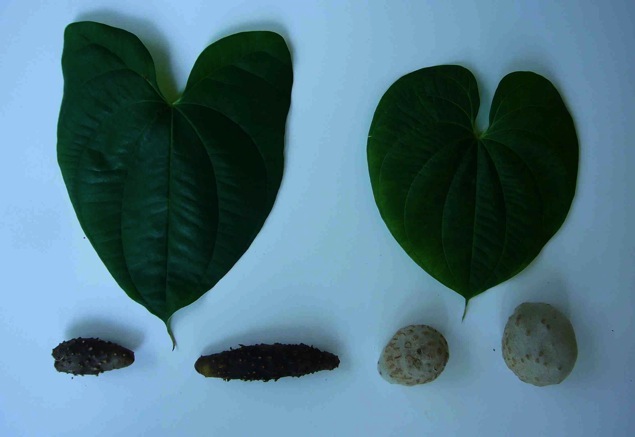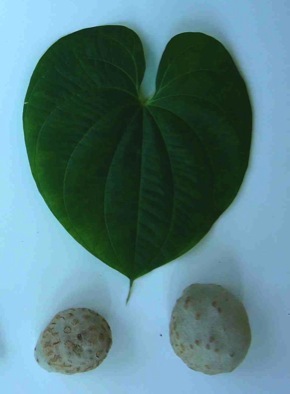The “Cheeky Yam, or Yam on the Lamb
Yam B, Dioscorea bulbifera, is definitely second best to Yam A, Dioscorea alata. Why is Yam B, the D. bulbifera second best? For two reasons. It requires more work to prepare it to eat, and doesn’t grow as big as D. alata. Let me tell you right now I have not yet dug up a Yam B tuber, but not from lack of trying. Despite decades of looking I’ve never found one. My friend, Dick Deuerling, has however, did. He’s the author of “Florida’s Incredible Wild Edibles.” Dick was a stickler for taxonomy so when he says he dug up a D. Bulbifera tuber, not a D. alata tuber, boiled it twice and ate it, I believe him. I’d ask him to do it again but he’s past 90 and doesn’t get around well anymore.
The yam in question, D. bulbifera, ((Dye-os-KOH-ree-uh or in Greek thee-oh-skor-REE-uh)) is the green scourge of Central Florida, ….and South Florida, ….and North Florida…. watch out Georgia here she comes…. It was sent to a researcher in Orlando in 1905 as a possible ornamental and food crop. He reported it would be a dangerous plant to Florida but didn’t kill the plants he experimented with. A little over a century later it now carpets many parts of the state.
That D. bulbifera can be an attractive ornamental is attested by tourists mistakingly taking it home to plant. That it was a potential food crop is debatable. While there may be one species of D. bulbifera there are many varieties. I have noticed, for example, that some have smooth tan round in-the-air bulbils (probably Asian backgound) and others have dark brown bumpy round in-the-air bulbils with tan pimples (probaby African background.) What variety was sent to Orlando was not recorded.
D. bulbifera’s underground root is always referred to as toxic but also eaten in some places. How’s that for ambiguous? And it gets worse, the …. in-the-air bulbils… wrongly called “air potatoes” apparently vary in toxicity, some edible some not. While the bulbils are constantly called toxic by authorities rumor persists they are edible (with special preparation.) In fact I had a visitor from Brazil a couple of years agoy while I had some D. bulbifera bulbils (Asian: Smooth and tan) on my desk. He said his mother cooked them all the time. I asked him to ask her how she does it. (Crushes, dries, bakes, leaches then uses.) On the other hand Dick had two friends boil D. bulbifera in-the-air bulbils and had to go to the hospital (Asian or African not known.) To make matters worse some writers make no linguistic distinction between the above ground in-the-air bulbils and below ground (in the dirt) roots compounding the confusion by calling them both “tubers. ” And technically the underground tubers are not roots but rather “adventurous stem material.”

Yam A, the Alata on let with in-the-air bulbils, on the right is Yam B, with in the air-bulbils. No root is shown.
The D. bulbifera has large round ball to heart-shaped leaves and a round stem. It climbs at eye level from your lower right to upper left (called the S-twist) and has in-the-air bulbils that are round, brown and lumpy (African) or round smooth and tan (Asian) hence the nickname “air potato vine.” And to add to the confusion, Yam A, the Dioscorea alata, (uh-LAT-tuh) has dark brown bulbils as well but they tend to be 1) cylindrical and or 2) very misshapen, neither round or cylindrical, L-shaped, Y-shaped, or a lumpy lump. D. Bulbifera’s in-the-air bulbils are, to my knowledge, always round regardless of color. D. bulbifera can grow a root about the size of a softball (occasionally to a basket ball,) but apparently does not grow a large root too often if rarely in Florida. That would explain why I have never found one. In fact, I became so frustrated with the D. bulbifera, Yam B, I put it on the back burner, the way in the back, for over a decade.
Many years later I became a fan of Ray Mears, a British bush crafter. I ordered some of his DVDs and one of his books about wild edibles in England. Unexpectedly, the Dioscorea bulbifera came up. One of Mear’s episodes was about the Aborigines in Australia. They dig up two kinds of yams, one called “long yam” and one called “cheeky yam.” They steam roast them for a couple of hours then eat the “long yam” immediately but not the cheeky yam.” They grate the cheeky yam then leach it in a flowing stream overnight. Then they eat it. No botanical name was given for either yam. But when I was reading his book Mears happens to mention in passing there is one non-edible yam in England. Then he said it is similar to the one the Aborigines eat in Australia, the D. bulbifera. Well, as one might expect, that caught my attention. I was beginning to think my friend Dick was the only one who ever found a D. bulbifera root to eat but apparently the Aborigines had found them, too. Alas, we don’t know what varieties.
Researching yams again, this time with the internet, I discovered the “long yams” the Aborigines eat are, Dioscorea transversa. The D. transversa (trans-VER-sa) like the D. alata, twists when it grows, lower left to upper right, he Z-twist (as does Yam C, the Dioscorea polystachya mistakenly called D. oppositifolia.) The D. bulbifera, however, twists lower right to upper left, the S-twist. By now I was getting the idea that readily edible yams at eye level climb from your lower left to upper right. Z-twist, then behind. The ones that twist the other way, S-twist, need special preparation or are not edible at all. That may seem like a small observation but it took about a dozen years to sort out.
So I do know two things. Dick has eaten the D. Bulbifera undergound root and I have eaten the D. Alta’s underground root. In Dick’s book he says he boiled the root twice to get rid of the bitterness. Then, after peeling, he used it just like cooked potato. In Australia, to remind you, the Aborigines roast it for a couple of hours, grate it, and then leach it overnight in a flowing stream. I know Dick’s method works for Yam B found here in Florida. I don’t know if the Aborigines’ method would work with Yam B’s here. If I ever find one, I will try both ways and let you know.
And what of the bulbils? The bulbils of some D. bulbifera are reported as edible but they require special preparation as mentioned above. Just boiling will not do it. Often their preparation is peeling, sun drying (read long term chemical decay, not short term in an oven) then boiling. Another report is they are soaked then boiled. As third says they are cooked with lye, a method used with some horse chestnuts. A fourth says none of them are edible anyway.
My suspicion is there are different varieties of D. bulbifera and some may be edible in-the-air bulbils. What we do know is that even where they are eaten they are cut open to see if they turn brown quickly. Those that are are not used. And, in someplaces even after being careful in selecting the Yam B in-the-air bulbils and preparing them the are fed to a dog first to make use.
Green Deane’s “Itemized” Plant Profile
IDENTIFICATION: Dioscorea bulbifera: ”Air potato vine.’ Large heart-shaped leaves, alternating, stem round, climbs from lower right to upper left. Bulbils usually tan, round and smooth, Asian, or round and dark brown with light dimples, African. Underground root roundish, can be lumpy and distorted when grown in hard soil.
TIME OF YEAR: Fall, September to December. For two months the vine dies back making locating difficult.
ENVIRONMENT: Yams do well in sun or partial shade and prosper with ample rainfall. They require good drainage, and therefore, are often planted on mounds or ridges.
METHOD OF PREPARATION: Undergound roots, should you find one: Boil in two changes of water, peel, then slice or mash it, or bake it or chill it and use in a “potato” salad. Make sure it has absolutely no bitterness. I consider the in-the-air bulbils of the D. bulbifera as not edible. If they are it involves considerable process using multiple cooking methods.


